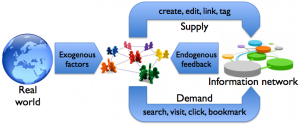
The Web Dynamics group worked to build a better understanding of how the Web, the Wikipedia, and similar large information networks, grow and change over their lifetime. Of particular interest is how nodes in these networks gain popularity.
This work leveraged data from the Wikimedia project, as well as from Mark Meiss, concerning traffic to Wikipedia pages and pages in the Internet at large.
Our work painted a picture of the Web as a place in which popularity is very dynamic and unpredictable. Surges in popularity for topics are similar to earthquakes and avalanches in terms of their unpredictability — both in when they will happen and on what scale. However, we found that spikes in popularity are often correlated with events in the news — as evidenced by positive correlation between Google Trends data and traffic to bursty Wikipedia topics. Work on this project has been presented at SocialCom 2010 Symposium on Social Intelligence and Networking (SIN-10). A review of these issues with an emphasis on the modeling problem was also published in Physical Review Letters.
Finally, we studied the production of information in the attention economy — namely, how the production of new knowledge is associated to significant shifts of collective attention, which we take as proxy for its demand. This is consistent with a scenario in which allocation of attention toward a topic stimulates the demand for information about it, and in turn the supply of further novel information.







